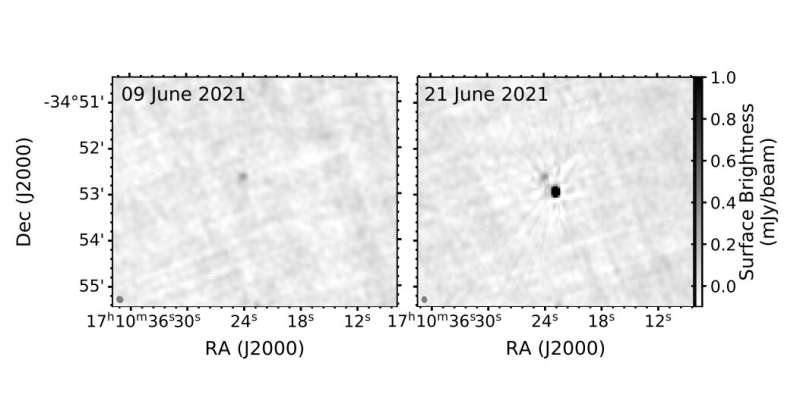June 28, 2023 report
This article has been reviewed according to Science X's editorial process and policies. Editors have highlighted the following attributes while ensuring the content's credibility:
fact-checked
preprint
trusted source
proofread
Astronomers discover an extremely intermittent radio pulsar

Using the MeerKAT telescope, an international team of astronomers has serendipitously discovered a new pulsar. The newfound object, designated PSR J1710−3452, turns out to be an extremely intermittent radio pulsar. The finding was reported June 19 on the pre-print server arXiv.
Pulsars are highly magnetized, rotating neutron stars emitting a beam of electromagnetic radiation. They are usually detected in the form of short bursts of radio emission; however, some of them are also observed via optical, X-ray and gamma-ray telescopes.
Recently, a group of astronomers led by Mayuresh Surnis of the Indian Institute of Science Education and Research Bhopal (IISER Bhopal) in India, has observed a millisecond pulsar known as PSR J1708−3506 with the MeerKAT telescope, as part of the MeerTIME program. During these observations, they serendipitously detected a new pulsar through its single pulses.
"The object was discovered through the detection of 97 bright radio pulses in only one out of 66 epochs of observations spanning almost three years. The bright pulses have allowed the source to be localized to a precision of 0.5" through radio imaging," the researchers wrote in the paper.
According to the study, PSR J1710−3452 has a relatively long spin period of about 10.4 seconds and its dispersion measure is 189 pc/cm3. The surface magnetic field strength of this pulsar was estimated to be at a level of 25 quadrillion Gauss.
The single pulses of PSR J1710−3452 were found to showcase broadly similar emission but a large diversity of structure on a smaller timescale than has been observed. Moreover, every single pulse has two main emission components separated by approximately 0.7 seconds with a total pulse width spanning more than one second, corresponding to a pulsed duty cycle of about 10%.
The astronomers noted that such a large duty cycle is often observed in radio-loud magnetars. In general, magnetars are neutron stars with extremely strong magnetic fields, more than one quadrillion times stronger than the magnetic field of our planet. Furthermore, the researchers assume that the highly intermittent nature of PSR J1710−3452 and its position in the Milky Way galaxy suggest that it may be part of an older population of magnetars.
"If this is indeed a magnetar, it is located at a relatively high galactic latitude (2.9°), making it potentially one of the oldest and the most intermittent magnetars known in the Galaxy. The very short activity window of this object is unique and may point towards a yet undetected population of long period, highly transient radio emitting neutron stars," the authors of the paper concluded.
The astronomers added that further investigation of PSR J1710−3452 and more discoveries of similar sources are required in order to confirm the old magnetar scenario for this pulsar.
More information: M. P. Surnis et al, Discovery of an Extremely Intermittent Periodic Radio Source, arXiv (2023). DOI: 10.48550/arxiv.2306.10817
Journal information: arXiv
© 2023 Science X Network





















